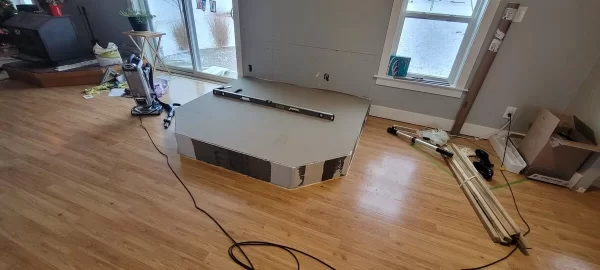Greetings!
We bought a house in Michigan about 15 years ago that had an old Sierra woodstove (70's?). Due to it's proximity to the living space we've decided to move it so we can allow for more room for seating in our living room. I've gotten most of the pad built per the instructions in the NFPA 211 section 13.5.2.1...
13.5.2.1 Room heaters, fireplace stoves, room heater/fireplace stove combinations, or ranges that are set on legs or pedestals that provide not less than 6 in. (152 mm) of ventilated open space beneath the fire chamber or base of the appliance shall be permitted to be placed on floors of combustible construction, provided the following conditions exist:
(1) The floor under the appliance is protected with closely spaced solid masonry units not less than 2 in. (51 mm) in thickness.
(2) The top surface of the masonry is covered with sheet metal not less than 24 gauge [0.024 in. (0.61 mm)].
(3) The floor protection extends not less than 18 in. (457 mm) beyond the appliance on all sides.
For the sake of discussion I've essentially poured a 2"+ thick concrete pad for the unit to sit on but I'm struggling to understand the reason for the sheet metal. Is there an approved design that I can implement to avoid having to use this? My plan to finish things out is to tile and grout the top and sides of the pad. That said, the layer of sheet metal adds a level of complexity to finishing with tile as I'm not sure of a solid way of integrating this in for a tiled application. Hoping someone here has some advice for me either in how to eliminate the sheet metal entirely from the design or how to integrate it in so I can have a tiled finish that will end up solid and not crack.
For reference, the current pad is 2" patio block sitting on a piece of 1-1/2" thick MDF installed in 1997.
Greatly appreciate any advice! Thanks!
![20221216_134532[1].jpg 20221216_134532[1].jpg](https://www.hearth.com/talk/data/attachments/305/305392-59d035f6f9877ecd0f085491bcca5933.jpg)

We bought a house in Michigan about 15 years ago that had an old Sierra woodstove (70's?). Due to it's proximity to the living space we've decided to move it so we can allow for more room for seating in our living room. I've gotten most of the pad built per the instructions in the NFPA 211 section 13.5.2.1...
13.5.2.1 Room heaters, fireplace stoves, room heater/fireplace stove combinations, or ranges that are set on legs or pedestals that provide not less than 6 in. (152 mm) of ventilated open space beneath the fire chamber or base of the appliance shall be permitted to be placed on floors of combustible construction, provided the following conditions exist:
(1) The floor under the appliance is protected with closely spaced solid masonry units not less than 2 in. (51 mm) in thickness.
(2) The top surface of the masonry is covered with sheet metal not less than 24 gauge [0.024 in. (0.61 mm)].
(3) The floor protection extends not less than 18 in. (457 mm) beyond the appliance on all sides.
For the sake of discussion I've essentially poured a 2"+ thick concrete pad for the unit to sit on but I'm struggling to understand the reason for the sheet metal. Is there an approved design that I can implement to avoid having to use this? My plan to finish things out is to tile and grout the top and sides of the pad. That said, the layer of sheet metal adds a level of complexity to finishing with tile as I'm not sure of a solid way of integrating this in for a tiled application. Hoping someone here has some advice for me either in how to eliminate the sheet metal entirely from the design or how to integrate it in so I can have a tiled finish that will end up solid and not crack.
For reference, the current pad is 2" patio block sitting on a piece of 1-1/2" thick MDF installed in 1997.
Greatly appreciate any advice! Thanks!
![20221216_134532[1].jpg 20221216_134532[1].jpg](https://www.hearth.com/talk/data/attachments/305/305392-59d035f6f9877ecd0f085491bcca5933.jpg)


